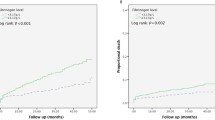Abstract
Few reports have so far investigated the relationship between fibrinogen levels and the extent of coronary artery disease (CAD) as evaluated by coronary angiography, that is therefore the aim of the current study. We measured fibrinogen in 2,121 consecutive patients undergoing coronary angiography. Patients were divided in 5 groups based on quintiles of fibrinogen levels. Significant CAD was defined as stenosis >50% in at least 1 coronary vessel. We additionally measured carotid intima-media thickness (CIMT) in a subgroup of 359 patients. Patients with elevated fibrinogen were older (P = 0.038), with larger prevalence of diabetes (P = 0.027), female gender (P < 0.0001), hypertension (P < 0.001), chronic renal failure (P < 0.0001), previous CVA (P = 0.036), less often with family history of CAD (P = 0.019) and previous PCI (P < 0.0001), more often presenting with ACS (P < 0.0001), more often on nitrates (P < 0.0001), clopidogrel (P = 0.009) and diuretics (P < 0.0001). Fibrinogen levels were linearly associated with baseline glycaemia (P < 0.017), WBC count (P < 0.0001), creatinine (P < 0.0001), and Platelet count (P < 0.0001) but inversely associated with RBC count (P < 0.0001). Fibrinogen levels were associated with CAD (P = 0.001), especially for extremely high levels (5th percentile, P < 0.0001). At multivariate analysis, after correction for baseline confounding factors, high fibrinogen level (5th percentile) was still associated with the prevalence of CAD (P = 0.034). Furthermore, fibrinogen levels were related with maximal CIMT (r = 0.12; P = 0.01), with larger prevalence of carotid plaques in patients with higher fibrinogen levels (5th quintile) as compared to remaining patients (P = 0.046). This study showed that high fibrinogen level is significantly associated with CAD and carotid atherosclerosis.



Similar content being viewed by others
References
Meade TW, Mellows S, Brozovic M et al (1986) Haemostatic function and ischaemic heart disease: principal results of the Northwick Park Heart Study. Lancet 2:533–537
Ernst E, Resch KL (1993) Fibrinogen as a cardiovascular risk factor: a meta-analysis and review of the literature. Ann Intern Med 118:956–963
Danesh J, Collins R, Appleby P, Peto R (1998) Association of fibrinogen, C-reactive protein, albumin, or leukocyte count with coronary heart disease: meta-analyses of prospective studies. JAMA 279:1477–1482
Feinbloom D, Bauer K (2005) Assessment of hemostatic risk factors in predicting arterial thrombotic events. Arterioscler Thromb Vasc Biol 25:2043–2053
Fibrinogen Studies Collaboration (2005) Plasma fibrinogen level and the risk of major cardiovascular diseases and nonvascular mortality: an individual participant meta-analysis. JAMA 294:1799–1809
Bielak LF, Klee GG, Sheedy PF et al (2000) Association of fibrinogen with quantity of coronary artery calcification measured by electron beam computed tomography. Arterioscler Thromb Vasc Biol 20:2167–2171
Baldassarre D, de Jong A, Amato M et al (2008) Carotid intima–media thickness and markers of inflammation, endothelial damage and hemostasis. Ann Med 40:21–44
Tracy RP (2003) Thrombin, inflammation, and cardiovascular disease: an epidemiologic perspective. Chest 124:49S–57S
Hansson GK (2005) Inflammation, atherosclerosis, and coronary artery disease. N Engl J Med 352:1685–1695
De Luca G, van’t Hof AW, Ottervanger JP, Hoorntje JC, Gosselink AT, Dambrink JH, de Boer MJ, Suryapranata H (2005) Ageing, impaired myocardial perfusion, and mortality in patients with ST-segment elevation myocardial infarction treated by primary angioplasty. Eur Heart J 26:662–666
Danesh J, Collins R, Peto R, Lowe GDO (2000) Haematocrit, viscosity, erythrocyte sedimentation rate: meta-analyses of prospective studies of coronary heart disease. Eur Heart J 279:515–520
Sinzinger H, Pirich C (1992) Platelet function and fibrinogen. In: Ernst E, Koenig W, Lowe GDO, Meade TW (eds) Fibrinogen: a “new” cardiovascular risk factor. Blackwell-MZV, Vienna, pp 46–50
Kim PY, Stewart RJ, Lipson SM, Nesheim ME (2007) The relative kinetics of clotting and lysis provide a biochemical rationale for the correlation between elevated fibrinogen and cardiovascular disease. J Thromb Haemost 5:1250–1256
Smith EB, Crosbie L (1992) Fibrinogen and fibrin in atherogenesis. In: Ernst E, Koenig W, Lowe GDO, Meade TW (eds) Fibrinogen: a “new” cardiovascular risk factor. Blackwell-MZV, Vienna, pp 4–10
Green D, Foiles N, Chan C, Schreiner PJ, Liu K (2009) Elevated fibrinogen levels and subsequent subclinical atherosclerosis: the CARDIA Study. Atherosclerosis 202:623–631
Rodrigues TC, Snell-Bergeon JK, Maahs DM, Kinney GL, Rewers M (2010) Higher fibrinogen levels predict progression of coronary artery calcification in adults with type 1 diabetes. Atherosclerosis 210:671–673
Taylor AJ, Bindeman J, Le TP et al (2008) Progression of calcified coronary atherosclerosis: relationship to coronary risk factors and carotid intima–media thickness. Atherosclerosis 197:339–345
Author information
Authors and Affiliations
Consortia
Corresponding author
Rights and permissions
About this article
Cite this article
De Luca, G., Verdoia, M., Cassetti, E. et al. High fibrinogen level is an independent predictor of presence and extent of coronary artery disease among Italian population. J Thromb Thrombolysis 31, 458–463 (2011). https://doi.org/10.1007/s11239-010-0531-z
Published:
Issue Date:
DOI: https://doi.org/10.1007/s11239-010-0531-z




